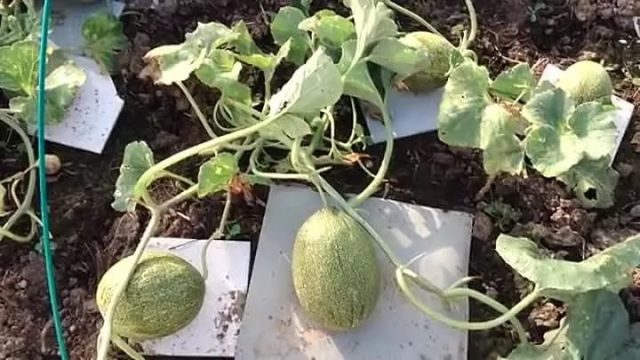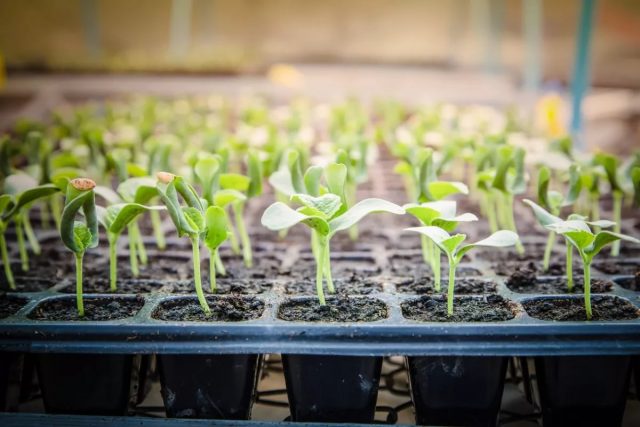Content
Melon bush formation is the basis for a good harvest. Without this, the plant will uncontrollably grow green mass, and you can not wait for the fruits at all. This procedure is quite simple, but it requires certain skills from gardeners.
Why you need to shape the melon
Traditionally, melon is considered a southern crop, but the latest achievements of breeders have made it possible to grow it even in the middle lane. At the same time, the fruits ripen perfectly even with the growth of plants in open ground. Since the melon is characterized by intensive growth, the size of the plant is artificially limited. This allows you to direct nutrients not to the uncontrolled growth of shoots, but to the ripening of fruits.
Melon formation has another challenge. This plant is dioecious, with male flowers appearing on the central stem and female flowers on the lateral shoots. If you do not form the plant, side shoots may not appear or there will be too few of them. In this case, the crop may be absent altogether or be very poor, since there will simply be nothing to pollinate. Formation allows you to grow the required number of side shoots, thereby rationing and improving the quality of the future harvest.
Recommended timing
There is no exact timeframe for the work on the formation of the melon bush. You need to focus only on the stages of development and the state of the plant. The first pinching of melon shoots is carried out at the stage of growing seedlings, then after planting the plants in open ground and at the stage of ovary formation. After that, only the removal of excess flowers and stepsons is performed.
How to properly shape a melon
The plant is formed by pinching. It consists in the fact that the shoot growth point is removed from the plant. After that, it ceases to grow in length, and the growth of lateral branches of the next order begins from it, which also pinch after the formation of a certain number of ovaries on them.
Pinching is usually done with a fingernail or fingers. Herbaceous shoots are easy to remove without any tools. To prevent decay, the pinching sites are treated with charcoal or sulfur.
Melon Formation Schemes
Most often, two schemes are used for growing melons in the open field:
- Grown on trellises.
- Growing on the ground (in spread).
Both methods have their own advantages and disadvantages. The tapestry method saves space, however, it requires additional arrangement of the beds and regular monitoring of the plants. As it grows, the central stem of the plant must be twisted around a rope that goes down from the trellis to the root.
The spreading method is simpler, but the planting takes up much more space. Depending on the method of growing melons in the open field, an appropriate formation scheme is also used.
How to form bushes when growing melon in spread
During the formation of a melon grown in a spread, the two most developed shoots are left. After 3-4 fruit ovaries are formed on them, they are pinched, leaving a couple of sheets above the last ovary.In the future, remove all unnecessary ovaries, remove stepchildren, pinch the growth point of third-order shoots.
How to form bushes when growing melons on trellises
The formation of a melon bush when grown on a trellis is almost identical. The point of growth of the main shoot is pinched after it reaches the trellis, i.e. 2 m. 2-3 ovaries are left on two side shoots, above which pinching is performed. The main stem is completely cleaned up to a height of 0.8-1 m. In the future, all stepchildren, newly formed ovaries, flowers are removed.
Melon formation depending on the ripening period of the variety
The order of formation of a melon bush depends on the variety, or rather, on the timing of its ripening. Early ripening varieties, due to the high ripening rate, require much less nutrients for full ripening, therefore, to form, it is enough to pinch the central stem and monitor the number of ripening fruits, timely removing excess fruit ovaries.
In unfavorable weather conditions, all the forces of the plant are directed to accelerate the ripening of fruits, therefore, melon bushes in the northern regions are often formed into one trunk (lateral shoot), leaving 1-2 fruit ovaries on it.
Late melon varieties form a little differently. It consists of several stages:
- Pinching at the stage of growing seedlings. Produced after 4-5 true (not cotyledonous) leaves are formed on the plant.
- Pinching a young plant. Carried out after 7 leaves have formed on the liana. They pinch the shoot over them, remove the extra flower ovaries and stepchildren.
In a short summer, preference should be given to early ripening varieties. Some hybrids are capable of ripening even in 75-80 days, which makes it possible to grow them outdoors even in the Moscow region. Later varieties in such regions can only mature in greenhouses.
Frequency of formation
The melon has a high shoot formation, therefore it forms new stepchildren regularly. They must be removed in a timely manner. Such activities should be carried out right up to the moment of harvesting so that nutrients are not wasted on their growth. Excess fruit ovaries must also be removed regularly.
Informative video about the basic principles of forming a melon bush:
What mistakes gardeners often make
The main mistake a gardener makes when forming a melon is improper pinching. Often they try to form a bush like a watermelon, but this is not true. Watermelon forms fruit ovaries on the central stem, melon - on the lateral processes. The only exceptions are hybrid varieties. In addition, there are a few more common mistakes.
- Fruit congestion. Often, in pursuit of the harvest, gardeners leave more fruit ovaries than the plant can feed under the appropriate conditions. It ends with the fact that instead of 2-3 juicy ripe fruits, the crop can consist of a dozen immature small melons that have neither taste nor aroma.
- Dense plantings. Melon needs space and sun. If several plants are close to each other, it can be quite difficult to determine where which shoot is growing and which bush it belongs to. Often they are so closely intertwined that it is almost impossible to separate them without damaging them.It is necessary to monitor the plantings, if necessary, adjust the direction of their growth, as well as remove unnecessary shoots and stepchildren in time.
The wrong choice of cultivars for outdoor cultivation is also a common mistake. In such cases, the crop may not ripen even if the gardener carried out all other activities on time and with proper quality. Therefore, when choosing seeds, it is imperative to pay attention to the maturation of plants, take them into account when planting seeds for seedlings.
Conclusion
The formation of a melon bush must be carried out with any growing method, especially in conditions of not quite suitable climate. If all the activities are carried out on time and in full, then these southern fruits can be grown in the middle lane. Modern hybrid varieties are capable of ripening even in a short cool summer, while the taste and aroma of such melons will differ little from those brought from the south.













